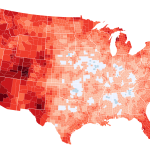The image of the family farm, a cornerstone of American identity, is frequently invoked in debates surrounding environmental regulations. However, a closer look reveals a more complex reality. The assertion that regulating agricultural pollution is impossible due to the sheer number of farms is a common refrain from industry lobbyists and sympathetic politicians. But is this claim accurate, or is it a smokescreen obscuring the significant environmental impact of large-scale industrial agriculture?
The “Millions of Farms” Myth
Former Agriculture Secretary Tom Vilsack’s statement that the US has “millions of farms” making regulation difficult is often cited to justify inaction. While the number of agricultural operations is indeed substantial, the vast majority are small, family-owned farms. The real environmental impact stems from a smaller subset – large-scale industrial farms, concentrated animal feeding operations (CAFOs), and vast monoculture fields dedicated to producing corn and soy for animal feed. These operations, often owned by corporations, contribute disproportionately to pollution, particularly water contamination from runoff containing fertilizers and animal waste. This concentration of pollution makes the argument about the sheer number of farms misleading. The focus should be on the significant polluters, not the overall count.
The Regulatory Gap and its Consequences
The current regulatory framework largely exempts these large-scale agricultural operations from the same level of environmental scrutiny applied to other industries. This discrepancy allows significant pollution to continue unabated, contributing to water contamination, greenhouse gas emissions, and biodiversity loss. While regulations exist, their enforcement and scope are often insufficient to address the scale of the problem. The lack of stringent oversight enables these operations to externalize their environmental costs, shifting the burden onto taxpayers and the environment itself. The Supreme Court’s recent decisions on the Clean Water Act have only further exacerbated this challenge, potentially limiting the government’s ability to regulate water pollution from agricultural sources.
The Need for Targeted Regulation
The solution isn’t to abandon regulation altogether; instead, a more targeted and effective approach is needed. This requires a shift in focus from the total number of farms to the concentrated sources of pollution. Strengthened regulations specifically targeting CAFOs and large-scale industrial farms, coupled with robust enforcement mechanisms, are crucial. Incentivizing sustainable agricultural practices, such as regenerative agriculture, and providing support for smaller, more environmentally responsible farms could also play a significant role. The myth of “millions of farms” serves to obscure the true nature of the problem and hinder the implementation of necessary reforms. Addressing the environmental impact of industrial agriculture requires acknowledging the reality of concentrated pollution and implementing policies that hold the major polluters accountable.
CONCLUSION:
The argument that the sheer number of American farms prevents effective pollution regulation is a distraction from the real issue: the significant environmental damage caused by large-scale industrial agriculture. By focusing on the major polluters and implementing targeted regulations, the US can begin to address the considerable environmental challenges posed by this sector and protect its natural resources. Ignoring this problem, based on a misleading premise, will only exacerbate the existing environmental crisis.
Based on materials: Vox





